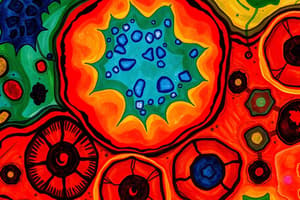Podcast
Questions and Answers
What characteristic distinguishes epithelial tissue from connective tissue?
What characteristic distinguishes epithelial tissue from connective tissue?
Epithelial tissue has closely packed cells with minimal extracellular matrix, whereas connective tissue consists of scattered cells within an extracellular matrix.
Why is the avascular nature of epithelial tissue significant for its function?
Why is the avascular nature of epithelial tissue significant for its function?
The avascular nature means epithelial tissue must rely on diffusion for nutrient supply, which influences its regenerative capacity and placement in the body.
Provide an example of simple cuboidal epithelium and its primary function.
Provide an example of simple cuboidal epithelium and its primary function.
An example of simple cuboidal epithelium is found in the kidney tubules, where its primary function is secretion and absorption.
What is the role of transitional epithelium, and where is it typically found?
What is the role of transitional epithelium, and where is it typically found?
Identify a function of connective tissue and explain its importance.
Identify a function of connective tissue and explain its importance.
Describe the composition and function of loose connective tissue.
Describe the composition and function of loose connective tissue.
What is the significance of dense regular connective tissue in the body?
What is the significance of dense regular connective tissue in the body?
How does the regenerative capacity of epithelial tissue compare to connective tissue?
How does the regenerative capacity of epithelial tissue compare to connective tissue?
What is the primary function of skeletal muscle tissue?
What is the primary function of skeletal muscle tissue?
How are cardiac muscle cells structurally different from skeletal muscle cells?
How are cardiac muscle cells structurally different from skeletal muscle cells?
What role does smooth muscle play in the body?
What role does smooth muscle play in the body?
Define contractility in the context of muscle tissue.
Define contractility in the context of muscle tissue.
What is the significance of intercalated discs in cardiac muscle?
What is the significance of intercalated discs in cardiac muscle?
How does the regenerative capacity of smooth muscle compare to cardiac muscle?
How does the regenerative capacity of smooth muscle compare to cardiac muscle?
What is Excitability in muscle tissue, and why is it important?
What is Excitability in muscle tissue, and why is it important?
What unique feature distinguishes skeletal muscle from the other types of muscle tissue?
What unique feature distinguishes skeletal muscle from the other types of muscle tissue?
Flashcards are hidden until you start studying
Study Notes
Epithelial Tissue
- Definition: A type of tissue that forms protective layers on body surfaces and organs.
- Characteristics:
- Cells are closely packed with minimal extracellular matrix.
- Avascular (lacks blood vessels); receives nutrients via diffusion.
- High regenerative capacity; cells can rapidly divide.
- Functions:
- Protection (e.g., skin).
- Absorption (e.g., intestines).
- Secretion (e.g., glands).
- Sensory reception (e.g., taste buds).
- Types:
- Simple Epithelium: Single layer of cells.
- Simple squamous: Thin and flat; facilitates diffusion (e.g., alveoli).
- Simple cuboidal: Cube-shaped; involved in secretion and absorption (e.g., kidney tubules).
- Simple columnar: Tall and column-like; often has microvilli (e.g., intestines).
- Stratified Epithelium: Multiple layers of cells.
- Stratified squamous: Protects against abrasion (e.g., skin).
- Stratified cuboidal: Rare; found in some glands.
- Stratified columnar: Also rare; found in male urethra.
- Pseudostratified Epithelium: Appears layered but is a single layer with varying cell heights (e.g., respiratory tract).
- Transitional Epithelium: Specialized for stretching; found in the bladder.
- Simple Epithelium: Single layer of cells.
Connective Tissue
- Definition: A diverse group of tissues that support, bind together, and protect organs and tissues.
- Characteristics:
- Consists of cells scattered within an extracellular matrix (ECM).
- Vascularity varies; some types are highly vascular (e.g., blood), while others are less so (e.g., cartilage).
- Functions:
- Support and structure (e.g., bone).
- Storage (e.g., adipose tissue for fat).
- Transport (e.g., blood).
- Defense (e.g., immune response).
- Types:
- Loose Connective Tissue: Provides flexibility and support; contains collagen and elastin fibers (e.g., areolar tissue).
- Dense Connective Tissue: Provides strength and resistance; includes:
- Dense regular: Parallel collagen fibers (e.g., tendons).
- Dense irregular: Randomly arranged fibers (e.g., dermis of the skin).
- Specialized Connective Tissues:
- Adipose tissue: Stores fat; insulates and protects organs.
- Cartilage: Provides flexibility and support; types include hyaline (e.g., joints), elastic (e.g., ear), and fibrocartilage (e.g., intervertebral discs).
- Bone: Rigid structure providing support and protection.
- Blood: Liquid connective tissue; transports nutrients, gases, and wastes.
Epithelial Tissue
- Forms protective layers on external surfaces and internal organs.
- Composed of tightly packed cells with minimal extracellular matrix.
- Lacks blood vessels; nutrients are absorbed through diffusion.
- Exhibits high regenerative capacity; cells can rapidly divide.
- Functions include:
- Protection: e.g., skin acts as a barrier.
- Absorption: e.g., intestinal lining facilitates nutrient uptake.
- Secretion: e.g., glandular tissues produce hormones or fluids.
- Sensory reception: e.g., taste buds detect flavors.
Types of Epithelial Tissue
-
Simple Epithelium: Single cell layer.
- Simple squamous: Flat cells; enhances diffusion (e.g., alveoli in lungs).
- Simple cuboidal: Cube-shaped cells; involved in secretion and absorption (e.g., kidney tubules).
- Simple columnar: Tall cells, often with microvilli for increased surface area (e.g., intestinal lining).
-
Stratified Epithelium: Multiple cell layers.
- Stratified squamous: Protects against wear (e.g., outer skin).
- Stratified cuboidal: Rare, found in some glands.
- Stratified columnar: Also rare; located in the male urethra.
-
Pseudostratified Epithelium: Single layer with varying cell heights giving a layered appearance (e.g., respiratory tract).
-
Transitional Epithelium: Specialized to stretch; found in the urinary bladder.
Connective Tissue
- A diverse group of tissues providing support, binding, and protection for organs and tissues.
- Composed of scattered cells within a prominent extracellular matrix (ECM).
- Vascularity varies; includes both highly vascular tissues (e.g., blood) and less vascular tissues (e.g., cartilage).
Functions of Connective Tissue
- Support and structure: e.g., bones provide the skeletal framework.
- Storage: e.g., adipose tissue stores energy in the form of fat.
- Transport: e.g., blood carries nutrients, gases, and waste products.
- Defense: e.g., immune responses facilitated by various connective tissues.
Types of Connective Tissue
-
Loose Connective Tissue: Flexible and supportive; contains collagen and elastin fibers (e.g., areolar tissue).
-
Dense Connective Tissue: Provides strength; includes:
- Dense regular: Parallel collagen fibers, found in tendons.
- Dense irregular: Randomly arranged fibers, found in the dermis of the skin.
-
Specialized Connective Tissues:
- Adipose tissue: Stores fat; functions in insulation and organ protection.
- Cartilage: Offers flexibility and support; types include:
- Hyaline: Found in joints for cushioning.
- Elastic: Provides shape; found in the ear.
- Fibrocartilage: Provides tensile strength; found in intervertebral discs.
- Bone: Rigid connective tissue providing support and protection.
- Blood: Liquid form of connective tissue; involved in nutrient and gas transport.
Overview of Muscle Tissue
- Specialized for contraction and movement, comprising elongated cells known as muscle fibers.
- Muscle fibers have the ability to shorten and generate force, facilitating various body movements.
Types of Muscle Tissue
-
Skeletal Muscle
- Characterized by a striated appearance and voluntary control over contractions.
- Primarily attached to bones through tendons, enabling body movement and maintaining posture.
- Responsible for heat production due to metabolic activity.
- Comprised of multinucleated cells, reflecting its growth and repair mechanisms.
-
Cardiac Muscle
- Exclusive to the heart, showing a striated structure with involuntary control.
- Intercalated discs connect cells, allowing for synchronized contractions essential for efficient blood pumping.
- Each cell typically contains a single nucleus and has a branched architecture, enhancing the heart's functional capacity.
-
Smooth Muscle
- Lacks striations and operates under involuntary control, found in walls of hollow organs (e.g., intestines, blood vessels).
- Composed of spindle-shaped cells that contain a single central nucleus.
- Regulates the flow of substances, playing a critical role in processes like digestion and blood circulation.
Characteristics of Muscle Tissue
- Excitability: Capable of responding to stimuli from nervous or hormonal signals.
- Contractility: Cells can shorten, generating tension and force.
- Extensibility: Ability to be stretched without damage.
- Elasticity: Muscle tissue can return to its original shape post-deformation.
Functions of Muscle Tissue
- Facilitates skeletal movement via skeletal muscle fibers.
- Ensures blood circulation throughout the body through cardiac muscle contractions.
- Aids in the movement of food and waste products via smooth muscle actions.
- Maintains body posture through constant muscle tone.
- Generates heat as a byproduct of muscle activity, contributing to thermoregulation.
Regeneration and Repair
- Skeletal muscle exhibits limited regenerative capacity, supported by satellite cells during repair.
- Cardiac muscle has a minimal ability to regenerate, with damage typically resulting in fibrosis, impacting heart function.
- Smooth muscle possesses strong regenerative capabilities, actively participating in tissue repair processes.
Studying That Suits You
Use AI to generate personalized quizzes and flashcards to suit your learning preferences.




